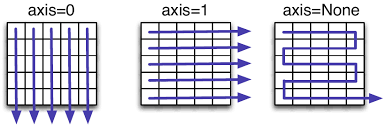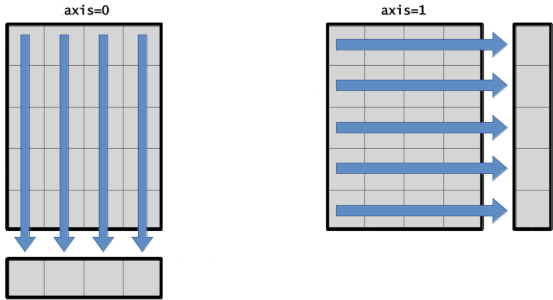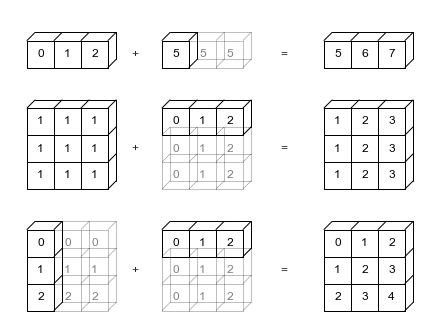Operations#
NumPy provides a large panel of vectorized operations. Vectorization describes the absence of any explicit looping in the code. Operations are applied on every element of the involved arrays in optimized pre-compiled C code. This is the key difference with respect to python lists, which makes NumPy more suitable to scientific computing.
import numpy as np
Binary operations#
Operations that involve two (or more) arrays are applied element-by-element. A new array is created and filled with the result.
a = np.array( [20, 30, 40, 50] )
b = np.array( [ 0, 1, 2, 3] )
c = a + b
print(c)
[20 31 42 53]
The two arrays should be exactly the same size. Errors are thrown if they are not.
a = np.array([1, 2, 3])
b = np.array([2, 2])
c = a * b # This will give an error when you run it!
---------------------------------------------------------------------------
ValueError Traceback (most recent call last)
Cell In[4], line 4
1 a = np.array([1, 2, 3])
2 b = np.array([2, 2])
----> 4 c = a * b # This will give an error when you run it!
ValueError: operands could not be broadcast together with shapes (3,) (2,)
One exception to the above rule is given by operations between an array and a scalar.
a = np.array([1,2,3])
b = 2
c = a * b
print(c)
[2 4 6]
Logical operations are also supported in NumPy.
x = np.array([3, 5, 2, 1, 4, 2])
y = np.array([1, 4, 7, 2, 5, 2])
w = (x > 3) & (y <= x) # "&" --> logical AND
z = (x==2) | (y==1) # "|" --> logical OR
print("w:", w)
print("z:", z)
w: [False True False False False False]
z: [ True False True False False True]
Unary operations#
Operations that involve one array are applied on all the elements.
x = np.array([[1,3,1],[2,5,1]])
s = x.sum()
print(s)
13
Parameter: axis#
Most of the unary operations return a scalar, because they operate on the array as it were a list of numbers, regardless of its shape. By specifying the axis parameter, you can apply the “reduction” operation along the specified axis of an array. For example:
axis=0applies the operation column-by-column.axis=1applies the operation row-by-row.

col_sum = x.sum(axis=0)
row_sum = x.sum(axis=1)
print("----- x -----")
print(x, "-> shape:", x.shape)
print("\n----- x.sum(axis=0) -----")
print(col_sum, "-> shape:", col_sum.shape)
print("\n----- x.sum(axis=1) -----")
print(row_sum, "-> shape:", row_sum.shape)
----- x -----
[[1 3 1]
[2 5 1]] -> shape: (2, 3)
----- x.sum(axis=0) -----
[3 8 2] -> shape: (3,)
----- x.sum(axis=1) -----
[5 8] -> shape: (2,)
Parameter: keepdims#
Note that reduction operations change the dimensions of the array: a matrix becomes a vector.
You can keep all the axes of the original array by setting the keepdims parameter to True.
A reduction along
axis=0gives a single-row matrix.A reduction along
axis=1gives a single-column matrix.

col_sum_keep = x.sum(axis=0, keepdims=True)
row_sum_keep = x.sum(axis=1, keepdims=True)
print("----- x -----")
print(x, "-> shape:", x.shape)
print("\n----- x.sum(axis=0, keepdims=True) -----")
print(col_sum_keep, "-> shape:", col_sum_keep.shape)
print("\n----- x.sum(axis=1, keepdims=True) -----")
print(row_sum_keep, "-> shape:", row_sum_keep.shape)
----- x -----
[[1 3 1]
[2 5 1]] -> shape: (2, 3)
----- x.sum(axis=0, keepdims=True) -----
[[3 8 2]] -> shape: (1, 3)
----- x.sum(axis=1, keepdims=True) -----
[[5]
[8]] -> shape: (2, 1)
Remark that the shape of the resulting array changes when you specify keepdims=True.
Broadcasting#
The term broadcasting describes how NumPy combines arrays with different shapes during arithmetics operations. As mentioned above, operations on two arrays are performed in an element-by-element fashion. In the simplest case, the arrays must have exactly the same shape.
a = np.array([1, 2, 3])
b = np.array([2, 2, 2])
c = a * b
NumPy’s broadcasting rule relaxes this constraint when the shapes of two arrays meet certain constraints. The simplest example occurs when an array and a scalar value are combined in an arithmetic operation. In this case, the scalar is stretched during the operation, so as to match the shape of the other array.
a = np.array([1,2,3])
b = 2
c = a * b
When operating on two arrays, NumPy compares their shapes element-wise. Subject to certain constraints, the smaller array is “broadcast” across the larger array so that they have compatible shapes. The following are three broadcasting scenarios that often arise in practice.
Scalars broadcast to any array.
Vectors broadcast to matrices with an equal number of columns.
Column matrices broadcast to any vector, and to matrices with an equal number of rows.

A common beginner mistake in NumPy is to unadvertely perform a binary operation with a single-column matrix and a vector. Due to broadcasting, this produces an unexpected result: each element of the former is combined to every element of the latter, resulting in a matrix of shape equal to the two addends:
vector = np.array([0,1,2])
column = np.array([[0],[1],[2]])
matrix = column + vector
print("----- vector -----")
print(vector)
print("\n----- column -----")
print(column)
print("\n----- column + vector -----")
print(matrix)
----- vector -----
[0 1 2]
----- column -----
[[0]
[1]
[2]]
----- column + vector -----
[[0 1 2]
[1 2 3]
[2 3 4]]
Exercises#
Solve the following exercises on array operations. Then, proceed to the next section.
Quiz 5#
Given an array
x, compute the following expression:\[ \log\left(\sum_{i=0}^{N-1} \exp(x_i) \right). \]
Hint:
\(\exp(\cdot)\) denotes the exponential, which can be computed in numpy with the function
np.exp().\(\sum_i \cdot\) denotes a summation, which can be computed in numpy with the function
np.sum().\(\log(\cdot)\) denotes the logarithm, which can be computed in numpy with the function
np.log().
# This is the array to work with
x = np.array([7.1, -5.7, 13])
log_sum_exp = None # YOUR CODE HERE
Quiz 6#
Find the minimum and maximum values of a vector.
Hint:
# This is the vector to work with
vector = np.array([5, -1, 3, 12, 8, 0])
min_value = None # YOUR CODE HERE
max_value = None # YOUR CODE HERE
Quiz 7#
Compute the mean value of a matrix, of its rows, and of its columns.
Hint: .mean()
np.random.seed(1)
# This is the matrix to work with
matrix = np.random.randint(10,size=(3,4))
mean_all = None # YOUR CODE HERE
mean_rows = None # YOUR CODE HERE
mean_cols = None # YOUR CODE HERE
